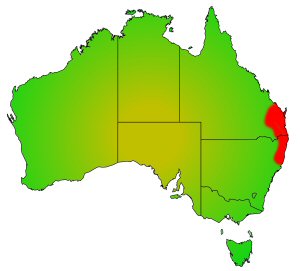Crimson Spotted Rainbowfish
|
Click to enlarge |
Scientific NameMelanotaenia duboulayi previously M. splendida fluviatilis
Other Common Names
Pink cheeked rainbowfish, Duboulay's rainbowfish, pink ear, Australian rainbowfish
Size
To 90 mm
Conservation Status
Common/Widespread
Distribution
 Occurs widely in eastern coastal drainages in southern Queensland and northern New South Wales
Occurs widely in eastern coastal drainages in southern Queensland and northern New South Wales
Habitat
Nearly always congregates in schools of more than 20 or 30 individuals. Swims just below the surface. Prefer clear still ponds with muddy bottoms and weed, quiet billabongs, streams and backwaters near thick vegetation in areas exposed to sunlight.
Reproduction
Performs extensive courtship displays in spring or early summer, pairing lasts only for spawning sequence. Males aggressive during this period, spawn with any female ready. Release up to 10 eggs at a time, 3 to 4 times a day usually in early morning. Eggs held in plants by long, thin filaments.
Diet
Small aquatic insects, also ants and other small insects from the water surface.
Angling
Not an angling species.
In the aquarium
An excellent aquarium fish, readily available through the aquarium trade.
Some dealers sell fish bred in South East Asia, which are often from stock in Germany where rainbowfish are very popular with aquarists. Unfortunately, these fish are generally of poorer quality than those bred in Australia and are showing the results of too many generations in captivity, with poor colouration and other problems. It is possible to buy wild-caught fish, that have been captured by licensed persons, and these are the best option if available. Alternatively, seek fish bred from wild caught stock.
Rainbowfish are hardy and well suited to normal tropical aquarium conditions. They are a good community fish and, in a larger tank, a school of rainbowfish can be quite spectacular. Best when lit from the side, rainbowfish have interesting markings with a beautiful electric blue undertone which shimmers in the right conditions.
Will do well on a variety of foods, but like many fish the very best can be expected only when some live food is included in the diet. Brine shrimp, blood worms and black worms are good choices. Use frozen food when fresh is not available.
Breeds in captivity, the female depositing the eggs on breeding mops provided by the aquarist or on cabomba, fox-tail or other fine vegetation. The larvae are very small and have tiny mouths and can therefore be difficult to raise, but once started there are not generally too many problems. Experienced aquarists should not have too much trouble.